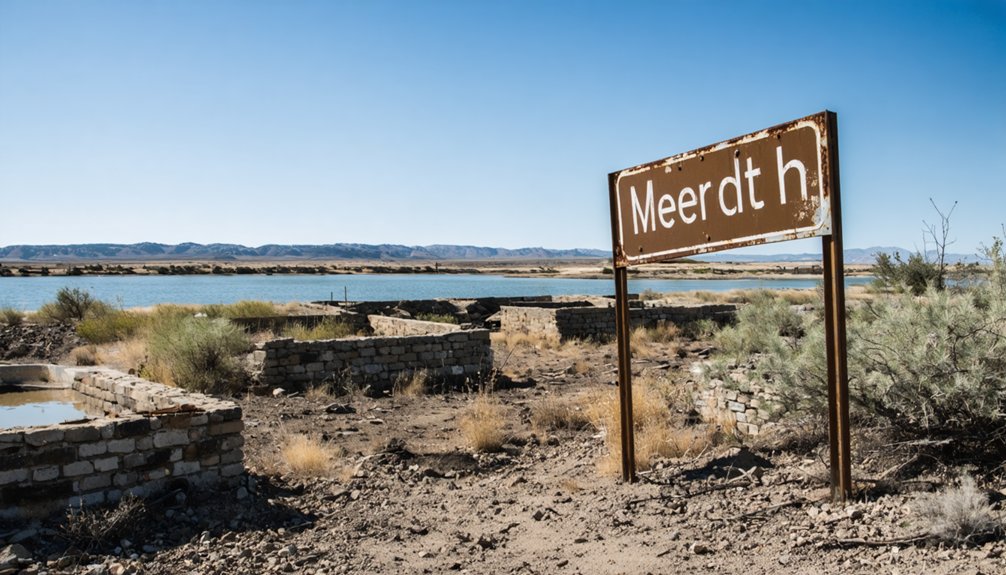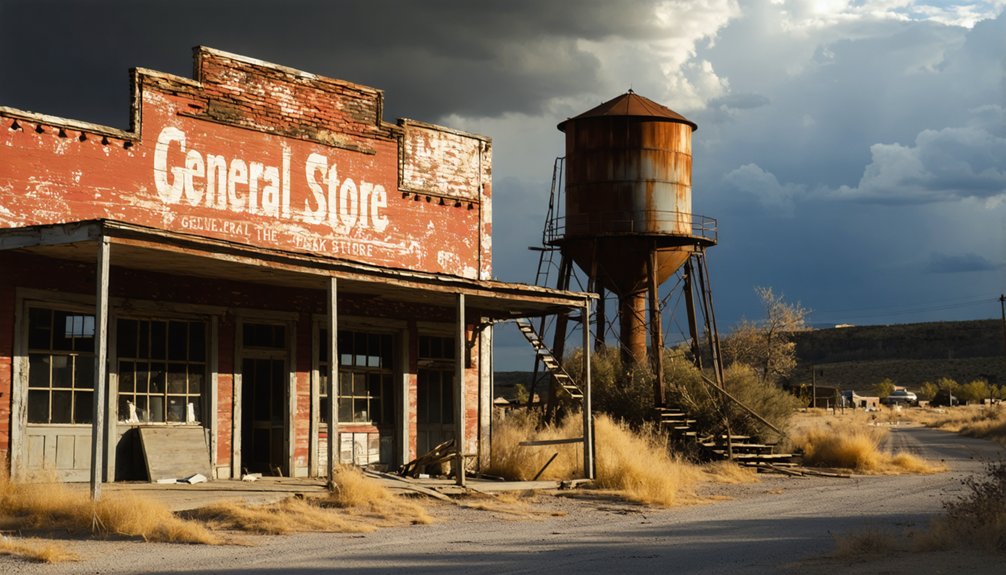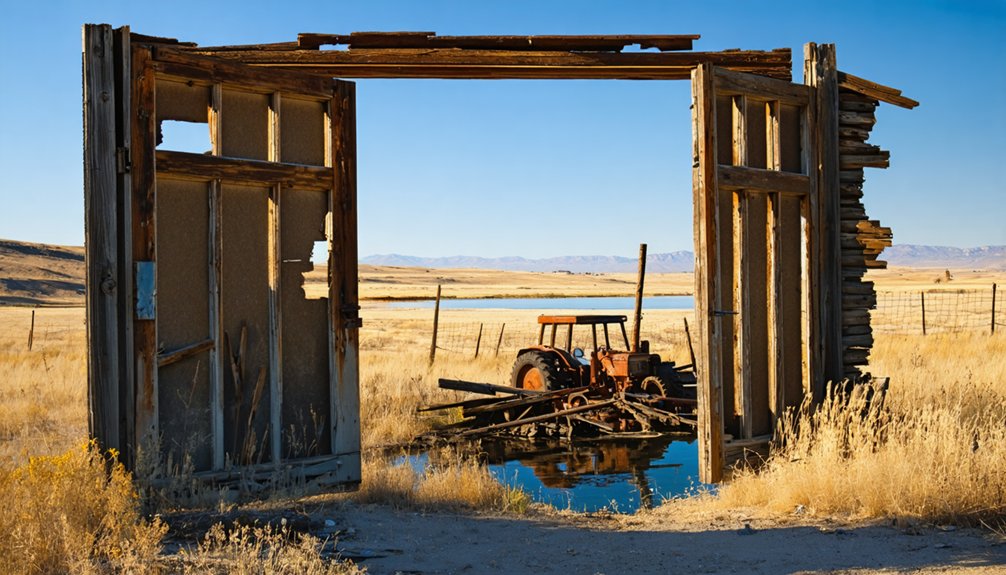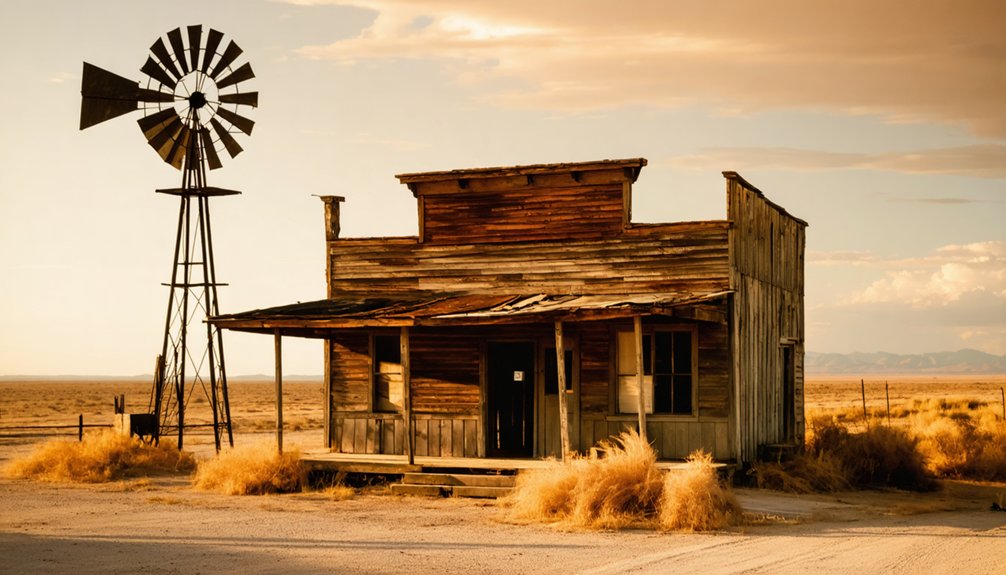You’ll find Canyon City‘s remains beneath the waters of Canyon Lake, about 13 miles northwest of New Braunfels, Texas. This once-thriving community began in 1887 when Lincoln Guy Conner established a general store and post office along the Guadalupe River. The town flourished until 1964, when the completion of Canyon Dam submerged the area. While the original buildings now rest underwater, the story of this ghost town reveals fascinating chapters of Texas Hill Country history.
Key Takeaways
- Canyon City became submerged after the construction of Canyon Dam in 1964, transforming a once-thriving community into an underwater ghost town.
- Originally surveyed in 1887 by Lincoln Guy Conner, the town featured a general store, post office, and the Victoria Hotel.
- The town’s location near Canyon Lake and Guadalupe River made it a vital trade hub before its submersion.
- Local families operated water-powered mills and farms until forced relocation by the U.S. Army Corps of Engineers.
- The town’s remains now lie beneath Canyon Lake, with historical societies preserving its memory through photographs and documents.
Origins of Canyon City’s Name and Location
Nestled in the Texas Hill Country, Canyon City draws its name from the dramatic landscape surrounding Canyon Lake and the nearby Guadalupe River.
You’ll find this community about thirteen miles northwest of New Braunfels, positioned at coordinates 29.87°N and -98.18°W along Farm Road 306.
The geography that inspired Canyon City’s naming reflects the rugged beauty of Comal County’s natural canyons and rolling terrain.
While many Texas towns trace their origins to the 19th century, this community’s development began in the 1960s following the completion of Canyon Dam in 1964.
Don’t confuse it with Canyon, Texas, in the Panhandle – this Hill Country settlement emerged as residents were drawn to the recreational opportunities of the newly formed lake and its pristine surroundings.
Today, this Comal County town continues to thrive as a small but vibrant community.
Located nearly 500 miles south of the better-known Canyon, Texas which sits at latitude 34.98°N and longitude -101.92°W in the Texas Panhandle region.
Early Settlements and Pioneer Families
When Lincoln Guy Conner first surveyed the site of Canyon City in December 1887, he couldn’t have imagined how his humble dugout would transform into a thriving community.
Using his home as a general store and post office, Conner laid the foundation for what would become Randall County’s seat. Pioneer challenges didn’t deter early settlers like A.L. Hammond, who quickly established the town’s second business and a blacksmith shop. The community grew stronger when Confederate veterans gathered annually for reunions over a ten-year period.
From humble beginnings as a home-based store, Canyon City grew through pioneer spirit into the heart of Randall County.
The Conner family’s legacy grew as they donated town lots to attract more settlers, while also building the Victoria Hotel and founding the first real estate office.
You’ll find that these founding families shaped Canyon City’s early development through their determination, creating a network of general stores, newspapers, and essential services that sustained the growing community. The area’s growth accelerated dramatically when the Pecos and Northern Texas Railway arrived in 1898, establishing vital shipping routes for the region’s cattle and cotton industries.
Life Along the Guadalupe River Valley
You’ll find evidence of Canyon City’s bustling river trade along the Guadalupe’s limestone banks, where settlers established routes to transport lumber and agricultural goods between scattered homesteads.
Local families operated water-powered grist and lumber mills, taking advantage of the river’s natural falls to process grain and timber harvested from the surrounding hills. The area’s rich Precambrian rocks formed the distinctive geological features that made the mills possible. The fertile Beaumont Formation underlying the floodplains provided ideal conditions for agriculture.
The river valley served as a natural gathering place for the community, with families congregating near the mills for social events, church meetings, and trading days that strengthened the bonds between isolated farmsteads.
River Trade Routes
Throughout the nineteenth century, the Guadalupe River served as an essential commercial artery that shaped the development of Texas settlements and trade networks.
You’ll find that river commerce flourished here, particularly between Victoria and Gulf ports, where natural river conditions were most favorable.
Mexican authorities first attempted to improve navigation in the 1820s, followed by similar efforts from the Republic of Texas and state legislature.
When the Civil War erupted, these trade routes proved vital, especially near Seguin where they connected local markets to Mexico. The county’s cotton production skyrocketed from 182 to 3,424 bales between 1850 and 1860, much of which was transported along these routes.
However, you’d notice a dramatic shift in transportation patterns once the San Antonio and Mexican Gulf Railway arrived in 1861.
This new rail connection effectively ended the river’s dominance in regional commerce, though the waterway’s legacy lived on through the Victoria Barge Canal. A 1935 feasibility study concluded that traditional river navigation was economically unfeasible, leading to alternative transportation solutions.
Mill Operations
The fertile Guadalupe River Valley became a hub of milling activity in the early 1850s when skilled operators James B. Crain and John Lackey established their operations.
You’d find their mills strategically placed near water crossings like Gum Spring, about 17 miles from New Braunfels. These entrepreneurs introduced essential mill innovations by harnessing the Guadalupe’s flow to power both gristmills and shingle mills.
The milling techniques they employed transformed local grain into flour and produced building materials that supported the growing settlements. Their operations attracted other businesses, creating vibrant communities like Hancock and Crane’s Mill. The area’s commerce was enhanced by German settlers’ arrival, bringing new farming practices to the valley. Local schools and dance halls emerged as the communities flourished around the mills.
The mills served as economic anchors, drawing settlers and fostering trade until Canyon Lake’s creation in the 1960s submerged these historic sites, marking the end of traditional milling in the valley.
Valley Community Gatherings
While the mills served as economic centers, they also became natural gathering spots for the valley’s diverse communities. You’d find German settlers from New Braunfels mixing with families from Victoria and Gonzales during community festivals, creating a vibrant social tapestry along the Guadalupe River.
These gatherings strengthened the bonds between settlements while preserving unique social traditions brought from Europe and adapted to Texas life.
- Church activities and school events anchored regular social interactions
- Seasonal harvest celebrations brought communities together for mutual support
- Market days near river crossings combined trade with socializing
- Local music and dance traditions, especially from German settlers, enriched community life
- Festive gatherings often centered around mills and trading posts where families naturally congregated
The Dam Project That Changed Everything

You’ll find the roots of Canyon Dam’s transformation in the late 1940s, when post-war planning and devastating floods sparked an ambitious flood control initiative that would reshape the entire Guadalupe River Valley.
The 1958 groundbreaking brought hundreds of construction workers to the area, establishing temporary camps and spurring the creation of Canyon City as a support community.
The rising waters of Canyon Lake by 1964 forced the relocation of longtime residents from settlements like Hancock and Crane’s Mill, marking the end of an era for these historic riverside communities.
Construction Timeline and Planning
After decades of devastating floods along the Guadalupe River, Congress authorized construction of Canyon Dam through the Rivers and Harbors Act of 1945, though final approval wouldn’t come until the Flood Control Act of 1954.
The construction impact transformed the area, turning what would become a ghost town into a massive engineering project.
You’ll find these key developments marked the timeline:
- Construction kicked off on June 27, 1958, at mile 303 of the Guadalupe River
- Tecon Corporation led site preparation and river rerouting
- The dam stretched 6,830 feet across the narrow valley
- Workers completed the rolled earthfill structure by 1964
- Reservoir filling began June 16, 1964, reaching full conservation pool by 1968
The project’s scope required extensive coordination between federal agencies, engineers, and local communities, forever changing the landscape of the Guadalupe River Basin.
Workforce Migration Impact
Before Canyon Dam transformed the region, few could have predicted the sweeping demographic changes its construction would bring. The project’s massive workforce needs drew a diverse labor pool, with immigrants making up a significant portion of the workers, reflecting Texas’s broader construction industry demographics.
You’ll find that this workforce migration permanently altered Canyon City’s social fabric. As workers settled in the area, they established new neighborhoods and brought cultural diversity that reshaped local institutions.
The influx spurred rapid economic diversification, transforming the once-rural region into a hub for tourism and recreation. New commercial centers emerged in places like Sattler and Startzville, while cultural integration led to multiethnic schools and churches.
This demographic shift wasn’t just temporary – it fundamentally changed the region’s identity and economic landscape.
Community Relocation Process
When Congress authorized the Canyon Dam construction in the late 1950s, the decision set in motion one of the most significant community relocations in Texas Hill Country history.
You’ll find that the transformation wasn’t just about moving homes – it reshaped entire communities and their way of life. The U.S. Army Corps of Engineers worked with affected families, demonstrating community resilience as they relocated approximately 70-80 graves and helped residents find new ground.
- Small communities of Cranes Mill and Hancock were completely submerged
- Fertile farmland and ranch properties were surrendered to the flood zone
- Historic buildings were either demolished or left to submersion
- Canyon City emerged in 1958 as a planned relocation center
- New subdivisions developed on higher ground, preserving historical memory through relocated cemeteries
Final Days Before the Waters Rose

During the final decade leading up to Canyon Lake’s creation, residents of Canyon City and neighboring settlements faced the inevitable reality of their towns’ submersion.
As Canyon Lake’s waters approached, entire communities confronted the looming fate of watching their towns vanish beneath the surface.
You’d have witnessed a gradual exodus as families packed up their lives, leaving behind homes that had sheltered generations. Final community gatherings marked the end of an era as schools closed, businesses shuttered, and churches held their last services.
The emotional community ties, some dating back to the 1850s, were stretched thin as residents dispersed to nearby cities. By the time construction finished in 1964, you’d have seen little more than empty buildings and abandoned streets awaiting the rising waters.
The transformation was complete by 1968, when over 8,000 acres of water claimed what remained of these once-vibrant communities.
Underwater Legacy: A Submerged Community
As the waters of Canyon Lake slowly rose in the 1960s, they claimed more than just land – they submerged entire communities rich with history.
Today, underwater archaeology reveals glimpses of Hancock and Crane’s Mill, towns that once thrived before the dam’s creation. During droughts, you’ll find their submerged heritage emerging from the depths, telling stories of pioneer life in Central Texas.
- Blacksmith artifacts and cotton gin remnants surface during low water periods
- Limestone caves with pristine stalagmites lie hidden beneath the waters
- Historic bridges and house foundations mark where families once lived
- Freed slaves’ graves represent important cultural heritage sites
- Original town remnants become visible roughly 8,000 acres under the lake’s surface
Transformation From Farmland to Lake Country

The fertile Guadalupe River Valley of Canyon City underwent a dramatic transformation from its agricultural roots in the mid-1800s to a thriving lake community by the 1960s.
You’ll find that early settlers like John Hancock and James B. Crain once established prosperous mills and farms along the valley, but by the 1950s, these agricultural communities faced steep farming decline and population loss.
Everything changed when the U.S. Army Corps of Engineers constructed Canyon Dam, completed in 1964.
The project submerged over 8,000 acres of former farmland, creating Canyon Lake. As waters rose, the area’s identity shifted dramatically from scattered farming settlements to a unified lake recreation destination.
The new Canyon City, established in 1958, embraced this change, developing infrastructure to support dam workers and tourists rather than agricultural pursuits.
Preserving the Memory of Lost Towns
While Canyon Lake’s waters now cover much of Canyon City’s physical heritage, dedicated efforts guarantee this historic settlement won’t fade from memory.
Though Canyon City lies beneath the lake today, passionate preservation work ensures its stories and significance endure through time.
Historical preservation initiatives combine traditional archival methods with modern digital technology, while community storytelling keeps the town’s legacy alive through oral histories and educational programs.
- Local historical societies maintain extensive collections of photographs, maps, and written records
- Digital repositories and virtual tours make Canyon City’s history accessible worldwide
- School programs and guided tours connect younger generations to their regional heritage
- Historical markers near the original site commemorate the submerged settlement
- Community events and lectures regularly showcase findings from archaeological surveys and archived documents
Similar Ghost Towns Across Texas
Throughout Texas, numerous ghost towns share similar fates to Canyon City, revealing patterns of boom-and-bust cycles that shaped the state’s development.
You’ll find Terlingua in West Texas, where quicksilver mining once drove a thriving economy, while East Texas’s Aldridge showcases the rise and fall of the lumber industry. These communities, like Canyon City, tell stories of Texas history through their abandoned structures and forgotten streets.
You can explore Belle Plain’s old jail and hotel ruins in Central Texas, or venture to Grapetown in the Hill Country to witness how changing transportation routes altered community destinies.
Each ghost town’s legacy lives on through deteriorating buildings, overgrown foundations, and local legends, preserving vital chapters of Texas’s pioneering spirit and economic evolution.
Frequently Asked Questions
Are There Any Visible Remains of Canyon City During Drought Conditions?
You won’t find documented remains of Canyon City during droughts, as there’s no archaeological evidence or historical preservation efforts recording visible structures. Flooding damage and modern development have erased most traces.
What Happened to the Gravestones and Cemeteries in the Flooded Area?
Like ghosts beneath the waves, your cemetery history lies submerged. Most grave markers weren’t relocated before Canyon Lake’s creation in 1964, leaving these stone sentinels silently guarding their underwater posts.
Did Any Original Canyon City Structures Get Relocated Before Flooding?
You won’t find documented evidence of historic preservation or relocation efforts for original Canyon City structures. When the lake filled in 1968, most buildings were simply abandoned and submerged beneath the waters.
Were There Any Legal Disputes Over Property Rights During Lake Development?
While you’d expect property ownership conflicts, there’s no record of major legal claims during Canyon Lake’s development. The government’s use of eminent domain likely settled disputes through standard compensation processes.
Do Any Surviving Residents Still Hold Annual Reunions or Commemorative Events?
Like a fading echo, you won’t find any annual gatherings by surviving residents. Historical records don’t indicate community memories being preserved through reunions since Canyon Lake submerged the town in the 1960s.
References
- https://mix941kmxj.com/the-strange-sad-story-of-a-texas-ghost-town-youll-never-visit/
- https://texashillcountry.com/the-deep-as-well-as-the-submerged-history-of-canyon-lake/
- https://www.tshaonline.org/handbook/entries/canyon-tx-randall-county
- https://www.amarillo.com/story/news/local/2014/06/13/panhandle-ghost-towns-hang-through-history/13269310007/
- https://en.wikipedia.org/wiki/List_of_ghost_towns_in_Texas
- https://www.texasescapes.com/TexasPanhandleTowns/CanyonTexas/CanyonTexas.htm
- https://www.canyontx.gov/58/History
- https://en.wikipedia.org/wiki/Canyon_City
- https://www.texasalmanac.com/places/canyon-city
- https://www.coordinatesfinder.com/coordinates/5748-canyon-texas



